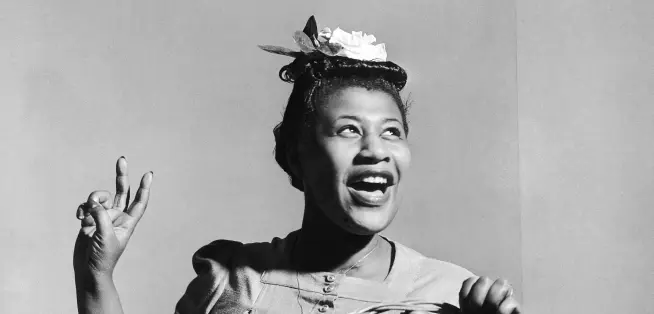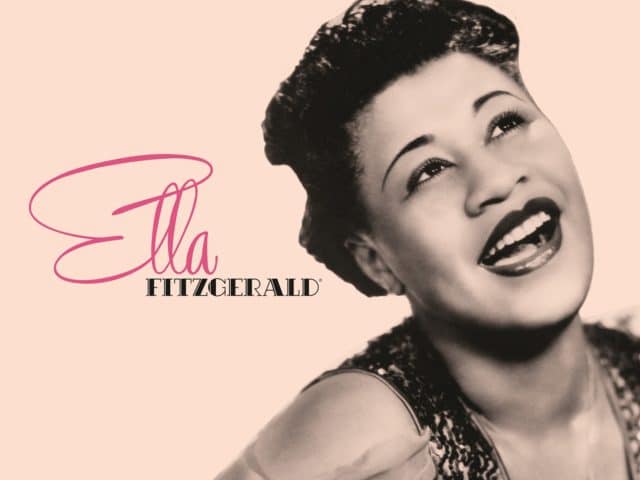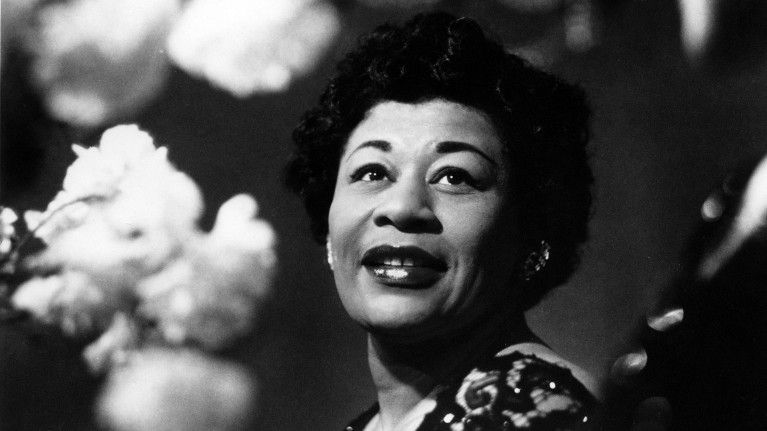Recognized worldwide as the "First Lady of Song", Ella Fitzgerald is arguably one of the greatest female vocalists of all time. Endowed with a high resonant voice, wide range and perfect diction, Fitzgerald also had a deft sense of swing, and with her brilliant singing technique she could stand up to any of her contemporaries.
She initially gained popularity as a member of a band organized by drummer Chick Webb in the 1930s. Together they recorded the hit "A-Tisket, A-Tasket", and then in the 1940s, Ella gained wide recognition thanks to her jazz performances in the Jazz at the Philharmonic and Dizzy Gillespie's Big Band bands.
Working with producer and part-time manager Norman Grantz, she gained even more recognition with her series of albums created at the Verve recording studio. The studio worked with various composers, the so-called "Great American Songwriters".
In her 50-year career, Ella Fitzgerald has received 13 Grammy Awards, sold over 40 million albums, and received numerous awards including the National Medal of Arts and the Presidential Medal of Freedom.
Fitzgerald, as an extremely important cultural figure, has had an immeasurable impact on the development of jazz and popular music and remains a bedrock for fans and artists decades after her departure from the stage.
How the girl survived hardships and terrible losses
Fitzgerald was born in 1917 in Newport News, Virginia. She grew up in a working-class family in Yonkers, New York. Her parents separated shortly after her birth, and she was largely raised by her mother Temperance "Tempy" Fitzgerald and mom's boyfriend Joseph "Joe" Da Silva.
The girl also had a younger half-sister, Frances, born in 1923. To help the family financially, Fitzgerald often earned money from odd jobs, including occasionally making money betting local gamblers.
As an overconfident teenage tomboy, Ella was active in sports and often played local baseball games. Influenced by her mother, she also enjoyed singing and dancing, and spent many hours singing along to records by Bing Crosby, Conna Boswell and the Boswell sisters. The girl also often took the train and went to a nearby town to watch a show with friends at the Apollo Theater in Harlem.
In 1932, her mother died from injuries sustained in a car accident. Deeply dismayed by the loss, Fitzgerald went through a difficult period. Then she constantly skipped school and got into trouble with the police.
She was subsequently sent to a reform school, where Ella was abused by her guardians. Eventually breaking free from the penitentiary, she ended up in New York in the midst of the Great Depression.
Despite all the difficulties, Ella Fitzgerald worked because she pursued her dream and an immeasurable love of performing.

Competitions and victories Ella Fitzgerald
In 1934, she entered and won an amateur competition at the Apollo, singing "Judy" by Hody Carmichael in the style of her idol, Conne Boswell. Saxophonist Benny Carter was with the band that evening, taking the young vocalist under his wing and encouraging her to continue her career.
More competitions followed, and in 1935 Fitzgerald won a week-long commercial with Teeny Bradshaw at the Harlem Opera House. There she met influential drummer Chick Webb, who agreed to try her out with his band at Yale. She captivated the crowd and spent the next few years with a drummer who became her legal guardian and redesigned his show to feature the young singer.
The band's fame grew exponentially with the Fitzgeralds as they dominated the battle of the bands in the Savoy, and released a series of works on Decca 78s, hitting "A Tisket-A-Tasket" in 1938 and the B-side single "T'aint What You Do (It's the Way That You Do It)", as well as "Liza" and "Undecided".
As the singer's career grew, Webb's health began to deteriorate. In his thirties, the drummer, who has struggled with congenital spinal tuberculosis throughout his life, is actually languishing from exhaustion after playing live shows. However, he continued to work, hoping that his group would continue to perform during the Great Depression.
In 1939, shortly after a major operation at the Johns Hopkins Hospital in Baltimore, Maryland, Webb died. After his death, Fitzgerald continued to lead her group with great success until 1941, when she decided to start a solo career.

New hit records
While still on the Decca label, Fitzgerald also teamed up with the Ink Spots, Louis Jordan and the Delta Rhythm Boys for several hits. In 1946, Ella Fitzgerald began working regularly for jazz manager Norman Grantz at the Philharmonic.
Although Fitzgerald was often perceived as a pop vocalist during her time with Webb, she began experimenting with "scat" singing. This technique is used in jazz when the performer imitates musical instruments with his own voice.
Fitzgerald toured with a large band of Dizzy Gillespie and soon adopted bebop (jazz style) as an integral part of her image. The singer also diluted her live sets with instrumental solos, which amazed the audience and earned her respect from her fellow musicians.
Her recordings of "Lady Be Good", "How High the Moon" and "Flying Home" from 1945-1947 were released to great acclaim and helped solidify her status as a major jazz vocalist.
Personal life is combined with the work of Ella Fitzgerald
While working with Gillespie, she met bassist Ray Brown and married him. Ray lived with Ella from 1947 to 1953, during which the singer frequently performed with her trio. The couple also adopted a son, Ray Brown Jr. (born to Fitzgerald's half-sister Francis in 1949), who continued his career as a pianist and vocalist.
In 1951, the singer teamed up with pianist Ellis Larkins for the Ella Sings Gershwin album, where she interpreted the songs of George Gershwin.
New label - Verve
After her appearance in Pete Kelly's The Blues in 1955, Fitzgerald signed with Norman Grantz's Verve label. Her longtime manager Granz specifically suggested Verve for the sole purpose of better showcasing her voice.
Beginning in 1956 with the Sings the Cole Porter Songbook, she would record an extensive series of Songbooks, interpreting the music of great American composers including Cole Porter, George and Ira Gershwin, Rodgers & Hart, Duke Ellington, Harold Arlen , Jerome Kern and Johnny Mercer.
The prestigious albums that earned Fitzgerald her first four Grammys in 1959 and 1958 further elevated her status as one of the great singers of all time.
The first release was followed by others that would soon become classic albums, including her 1956 duet hit with Louis Armstrong "Ella & Louis", as well as 1957's Like Someone in Love and 1958's "Porgy and Bess" also with Armstrong.
Under Grantz, Fitzgerald toured frequently, releasing several highly acclaimed live albums. Among them, in the 1960s, a performance of "Mack the Knife" in which she forgot the lyrics and improvised. One of the best-selling albums of her career, "Ella in Berlin", gave the singer the opportunity to receive a Grammy Award for Best Vocal Performance. The album was later inducted into the Grammy Hall of Fame in 1999.
Verve was sold to MGM in 1963, and by 1967 Fitzgerald found herself working without a contract. For the next few years, she recorded songs for several labels such as Capitol, Atlantic and Reprise. Her albums have also evolved over the years as she updates her repertoire with contemporary pop and rock songs such as Cream's "Sunshine of Your Love" and the Beatles' "Hey Jude".

Working for Pablo Records
However, her later years were again marked by Granz's influence after he founded the independent label Pablo Records. The live album Jazz at Santa Monica Civic '72, which featured Ella Fitzgerald, pianist Tommy Flanagan, and the Count Basie Orchestra, gained popularity through mail-order sales and helped launch Grantz's label.
More albums followed during the 70s and 80s, many of which paired the singer with artists such as Basie, Oscar Peterson and Joe Pass.
While diabetes has taken its toll on her eyes and heart, forcing her to take breaks from performing, Fitzgerald has always retained her joyful style and great swing feel. Away from the stage, she devoted herself to helping disadvantaged youth and contributed to various charities.
In 1979, she received the Medal of Honor from the Kennedy Center for the Performing Arts. Also in 1987, President Ronald Reagan awarded her the National Medal of Arts.

Other awards followed, including the "Commander in Arts and Literacy" award from France, as well as numerous honorary doctorates from Yale, Harvard, Dartmouth, and other institutions.
After a concert at New York's Carnegie Hall in 1991, she retired. Fitzgerald died on June 15, 1996 at her home in Beverly Hills, California. In the decades since her death, Fitzgerald's reputation as one of the most influential and recognizable figures in jazz and popular music has only increased.
She remains a household name throughout the world and has received a number of posthumous awards, including a Grammy and the Presidential Medal of Freedom.



